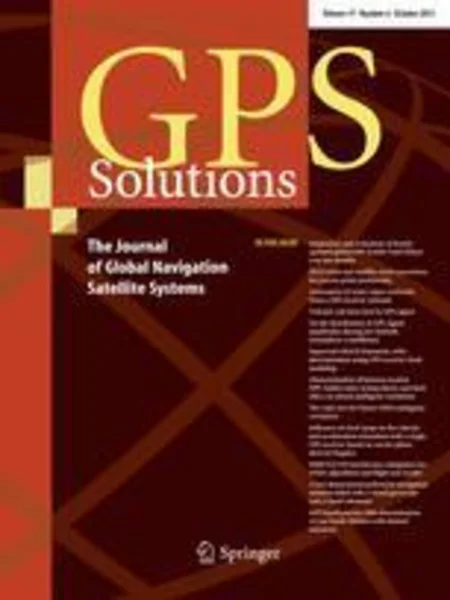-
characterization of between-receiver gps-galileo inter-system biases and their effect on mixed ambiguity resolution
جزئیات بیشتر مقاله- تاریخ ارائه: 1392/07/24
- تاریخ انتشار در تی پی بین: 1392/07/24
- تعداد بازدید: 1010
- تعداد پرسش و پاسخ ها: 0
- شماره تماس دبیرخانه رویداد: -
the global positioning system (gps) and galileo will transmit signals on similar frequencies, that is, the l1–e1 and l5–e5a frequencies. this will be beneficial for mixed gps and galileo applications in which the integer carrier phase ambiguities need to be resolved, in order to estimate the positioning unknowns with centimeter accuracy or better. in this contribution, we derive the mixed gps + galileo model that is based on “inter-system” double differencing, that is, differencing the galileo phase and code observations relative to those corresponding to the reference or pivot satellite of gps. as a consequence of this, additional between-receiver inter-system bias (isb) parameters need to be solved as well for both phase and code data. we investigate the size and variability of these between-receiver isbs, estimated from l1 and l5 observations of gps, as well as e1 and e5a observations of the two experimental galileo in-orbit validation element (giove) satellites. the data were collected using high-grade multi-gnss receivers of different manufacturers for several zero- and short-baseline setups in australia and the usa. from this analysis, it follows that differential isbs are only significant for receivers of different types and manufacturers; for baselines formed by identical receiver types, no differential isbs have shown up; thus, implying that the gps and giove data are then fully interoperable. fortunately, in case of different receiver types, our analysis also indicates that the phase and code isbs may be calibrated, since their estimates, based on several datasets separated in time, are shown to be very stable. when the single-frequency (e1) giove phase and code data of different receiver types are a priori corrected for the differential isbs, the short-baseline instantaneous ambiguity success rate increases significantly and becomes comparable to the success rate of mixed gps + giove ambiguity resolution based on identical receiver types.
مقالات جدیدترین رویدادها
-
استفاده از تحلیل اهمیت-عملکرد در ارائه الگوی مدیریت خلاقیت سازمانی و ارائه راهکار جهت بهبود
-
بررسی تاثیر ارزش وجوه نقد مازاد بر ساختار سرمایه شرکت های پذیرفته شده در بورس اوراق بهادار تهران
-
بررسی تأثیر سطح افشای ریسک بر قرارداد بدهی شرکت های پذیرفته شده در بورس اوراق بهادار تهران
-
بررسی تأثیر رتبه بندی اعتباری مبتنی بر مدل امتیاز بازار نوظهور بر نقد شوندگی سهام با تأکید بر خصوصی سازی شرکت ها
-
تأثیر آمیخته بازاریابی پوشاک ایرانی بر تصویر ذهنی مشتری پوشاک ایرانی (هاکوپیان)
-
بررسی تاثیر ابعاد قطعات بتنی در تعیین سرعت امواج فراصوتی و تاثیرآن در تخمین مقاومت فشاری بتن سخت شده
-
تحلیل حدی کران بالا ظرفیت بیرون کشیدکی لرزه ای مهار نواری افقی بر مبنای روش شبه دینامیکی
-
بهینه سازی هزینه و زمان در پروژه های ساخت
-
بررسی کمی و کیفی گونه جنگل کاری شده گز (.tamarix aphylla l) در حاشیه دریاچه ارومیه (مطالعه موردی: جبل کندی ارومیه)
-
مقایسه شتاب نگاشت های مقیاس شده و مصنوعی بر اساس طیف لرزه ای طراحی آیین نامه 2800
مقالات جدیدترین ژورنال ها
-
مدیریت و بررسی افسردگی دانش آموزان دختر مقطع متوسطه دوم در دروان کرونا در شهرستان دزفول
-
مدیریت و بررسی خرد سیاسی در اندیشه ی فردوسی در ادب ایران
-
واکاوی و مدیریت توصیفی قلمدان(جاکلیدی)ضریح در موزه آستان قدس رضوی
-
بررسی تاثیر خلاقیت، دانش و انگیزه کارکنان بر پیشنهادات نوآورانه کارکنان ( مورد مطالعه: هتل های 3 و 4 ستاره استان کرمان)
-
بررسی تاثیر کیفیت سیستم های اطلاعاتی بر تصمیم گیری موفق در شرکتهای تولیدی استان اصفهان (مورد مطالعه: مدیران شرکتهای تولیدی استان اصفهان)
-
تأثیر آموزش مهارت خودافشایی بر کاهش افسردگی دانش آموزان دختر مقطع متوسطه اول
-
مداخله ی آموزشی مبتنی بر مذهب بر نشانگان افسردگی زنان متاهل مراجعه کننده به مراکز فرهنگی شهر بابل
-
بررسی اثر دارویی استویا (stevia rebaudiana) در کنترل دیابت نوع دوم
-
بهره گیری از تکنیک خوشه بندی در ارتقای کارایی مدیریت ریسک در شرکتهای بیمه
-
evaluation the moisture susceptibility of asphalt mixtures containing demolished concrete waste materials




سوال خود را در مورد این مقاله مطرح نمایید :